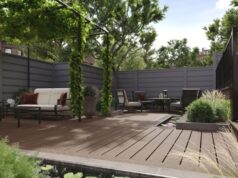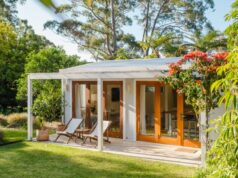
Having an audio system that lets you pipe music out to your backyard is fantastic, but requires a bit of careful planning and the right equipment.

Outdoor audio
If you are considering having audio all around your house, why stop at the back door? Having audio throughout your garden can be a great asset when you’re lounging in the pool or entertaining guests by the barbecue.
However, it is important to choose purpose-designed outdoor speakers. These resist the weather and usually even a bit of water exposure.
Even if you plan to install regular speakers up high, under the eaves of your home where they will be protected from rain, they will also have to resist greater extremes of temperature and humidity than you will typically find indoors. And they need to be better than most at coping with insects and spiders that want to make your speakers their home!
Proper outdoor speakers can handle this. They come in robust cases, normally with metal grilles to protect speaker cones from environmental attack and they generally use polypropylene materials in their speaker cones, rather than humidity-sensitive paper pulp.
Environment and speaker positioning
Acoustically speaking, the outdoors is not the best environment for speakers as there are normally lots of hard surfaces like pavements and brick walls that reflect the sound and bounce it everywhere. Additionally, the lack of other walls and ceilings make it hard to control the sound quality and volume levels – this isn’t an issue in an enclosed space.
For this reason, unlike indoor speaker positioning (where it is advisable to assess your room’s acoustics before you plan on making a purchase) it is more important to choose the best sounding and most weather-proof speakers you can, then experiment with the positioning and see how they sound before they are bolted down and the wiring is installed. Almost anywhere will do if all you need is some background music, though.
As for the speakers themselves, aside from sound quality, look for ones with high sensitivity. Ratings of above 88 dB (measured at one metre with 2.83 volts input) will mean more impressive volume levels and greater flexibility.
Controlling outdoor audio
A number of AV receivers come with remote control inputs and Zone 2 remote controls. You will have to add a remote infrared sensor (run its cable alongside the speaker cables), but not much more. A lot of major electronics brands have proprietary inter-unit controls, so if you buy all-Yamaha products for example, then the receiver will be able to control the DVD player or CD player.
Some units have infrared outputs as well, so you can also add an ‘IR Blaster’. Install this so that its transmissions can reach all the devices in your system, and you can use each individual component’s own remote controls via the receiver to control them – or a universal remote that’s been programmed to emulate each remote. If your system lacks those features, you can buy an inexpensive infrared repeater. This has an IR receiver which communicates wirelessly to an IR blaster unit.
On the other hand, if you are thinking of going this far, then you may be thinking of not just a sound system but a full outdoors AV system. In that case, you should get assistance from a professional.





